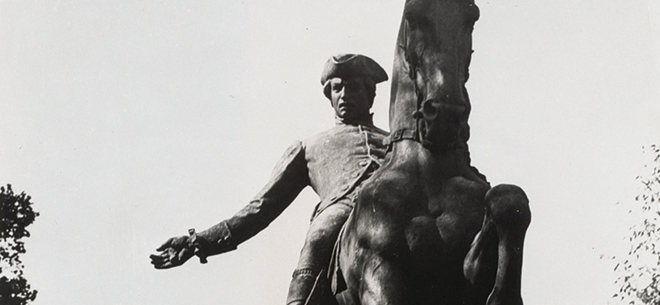
Listen, my children, and you shall hear
Of the midnight ride of Paul Revere.
So go the opening lines of Henry Wadsworth Longfellow’s 1860 poem “Paul Revere’s Ride” (later re-published as “The Landlord’s Tale” in 1863 as part of the collection Tales of a Wayside Inn), perhaps the most famous account of the events immediately preceding the American Revolution. As many historians have pointed out over the years, however, Longfellow’s verses are long on legend and short on facts. Indeed, the poet, likely having knowledge of the real details of the incident in question, instead employed significant artistic license in order to warn the country about a much-feared—and, as we know, inevitable—civil war. So just what did happen on that fateful night of April 18, 1775?
In the decade prior to the first shots fired at the Battles of Lexington and Concord marking the official start of open conflict against the British, Paul Revere was an active member of the Sons of Liberty, a clandestine organization opposed to the crown’s unfair treatment of its colonial subjects. As tensions continued to mount and it became clear on that spring day that troops would be deployed to seize a cache of weapons in the countryside surrounding Boston that belonged to the local militia, Son of Liberty Dr. Joseph Warren arranged for a warning to be sent to said militia and its leadership, including Samuel Adams and John Hancock. Two of the men chosen by Warren were Revere and William Dawes. Their mission was three-fold: Warn Adams and Hancock—mistakenly believed to be in danger of arrest—while rousing simpatico citizens along the way about the danger of the approaching Redcoats, as well as check on the store of arms in Concord. Dawes left first, taking the longer land route over Boston Neck, the narrow isthmus that then connected the Shawmut Peninsula forming the main part of the town to the mainland.
Revere’s first task before riding out was to arrange for a signal announcing British movements to his compatriots outside Boston in case he couldn’t make it out of the city, which was closed off by authorities just minutes after Dawes exited its confines. Knowing the Brits where embarking along the Charles River to complete their task, Revere had a friend—thought to be Robert Newman, the sexton of Christ Church—place two lanterns in the tower of the house of worship that would later be known as the Old North Church. Revere was then rowed, under cover of darkness, across the river to Charlestown, where he borrowed a horse to begin his epic journey.
Although British soldiers, aware the resistance may be active that night, were patrolling extensively, Revere managed to evade them to complete part of his mission around midnight when he arrived, about a half hour ahead of Dawes, at the house in Lexington where Adams and Hancock were staying. After a rest, both men attempted to reach their ultimate goal in nearby Concord. Met by fellow rider and like-minded rebel Dr. Samuel Prescott on the road, they were waylaid by British officers. All three scattered, with Revere suffering capture and Dawes losing his mount and retreating on foot. Only Prescott continued to Concord prior to the first shots of the war. The soldiers who detained Revere eventually released him, although they took his horse, forcing him to walk back to Lexington and rejoin Hancock, concluding a momentous night.
Fame for his actions that night escaped Revere in his lifetime. Longfellow’s poem, however, ensured its renown to this day.


